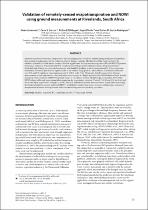 ResearchSpace
ResearchSpace
Validation of remotely-sensed evapotranspiration and NDWI using ground measurements at Riverlands, South Africa
JavaScript is disabled for your browser. Some features of this site may not work without it.
- ResearchSpace
- →
- Research Publications/Outputs
- →
- Journal Articles
- →
- View Item
| dc.contributor.author |
Jovanovic, Nebojsa

|
|
| dc.contributor.author |
Garcia, CL

|
|
| dc.contributor.author |
Bugan, Richard DH

|
|
| dc.contributor.author |
Teich, I

|
|
| dc.contributor.author |
Garcia Rodriguez, CM

|
|
| dc.date.accessioned | 2015-08-19T10:41:40Z | |
| dc.date.available | 2015-08-19T10:41:40Z | |
| dc.date.issued | 2014-03 | |
| dc.identifier.citation | Jovanovic, N., Garcia, C.L., Bugan, R.D.H., Teich, I., and Garcia Rodriguez, C.M. 2014. Validation of remotely-sensed evapotranspiration and NDWI using ground measurements at Riverlands, South Africa. Water SA, vol. 40(2), pp 211-220. | en_US |
| dc.identifier.issn | 0378-4738 | |
| dc.identifier.uri | http://hdl.handle.net/10204/8044 | |
| dc.description | Copyright: 2014 Water Research Commission. | en_US |
| dc.description.abstract | Quantification of the water cycle components is key to managing water resources. Remote sensing techniques and products have recently been developed for the estimation of water balance variables. The objective of this study was to test the reliability of LandSAF (Land Surface Analyses Satellite Applications Facility) evapotranspiration (ET) and SPOT-Vegetation Normalised Difference Water Index (NDWI) by comparison with ground-based measurements. Evapotranspiration (both daily and 30 min) was successfully estimated with LandSAF products in a flat area dominated by fynbos vegetation (Riverlands, Western Cape) that was representative of the satellite image pixel at 3 km resolution. Correlation coefficients were 0.85 and 0.91 and linear regressions produced R(sup2) of 0.72 and 0.75 for 30 min and daily ET, respectively. Ground-measurements of soil water content taken with capacitance sensors at 3 depths were related to NDWI obtained from 10-daily maximum value composites of SPOT-Vegetation images at a resolution of 1 km. Multiple regression models showed that NDWI relates well to soil water content after accounting for precipitation (adjusted R(sup2) were 0.71, 0.59 and 0.54 for 10, 40 and 80 cm soil depth, respectively). Changes in NDWI trends in different land covers were detected in 14-year time series using the breaks for additive seasonal and trend (BFAST) methodology. Appropriate usage, awareness of limitations and correct interpretation of remote sensing data can facilitate water management and planning operations. | en_US |
| dc.language.iso | en | en_US |
| dc.publisher | Water Research Commission (WRC) | en_US |
| dc.relation.ispartofseries | Worklist;14008 | |
| dc.subject | Fynbos | en_US |
| dc.subject | LandSAF ET | en_US |
| dc.subject | Scintillometry | en_US |
| dc.subject | SPOT-Vegetation NDWI | en_US |
| dc.title | Validation of remotely-sensed evapotranspiration and NDWI using ground measurements at Riverlands, South Africa | en_US |
| dc.type | Article | en_US |
| dc.identifier.apacitation | Jovanovic, N., Garcia, C., Bugan, R. D., Teich, I., & Garcia Rodriguez, C. (2014). Validation of remotely-sensed evapotranspiration and NDWI using ground measurements at Riverlands, South Africa. http://hdl.handle.net/10204/8044 | en_ZA |
| dc.identifier.chicagocitation | Jovanovic, Nebojsa, CL Garcia, Richard DH Bugan, I Teich, and CM Garcia Rodriguez "Validation of remotely-sensed evapotranspiration and NDWI using ground measurements at Riverlands, South Africa." (2014) http://hdl.handle.net/10204/8044 | en_ZA |
| dc.identifier.vancouvercitation | Jovanovic N, Garcia C, Bugan RD, Teich I, Garcia Rodriguez C. Validation of remotely-sensed evapotranspiration and NDWI using ground measurements at Riverlands, South Africa. 2014; http://hdl.handle.net/10204/8044. | en_ZA |
| dc.identifier.ris | TY - Article AU - Jovanovic, Nebojsa AU - Garcia, CL AU - Bugan, Richard DH AU - Teich, I AU - Garcia Rodriguez, CM AB - Quantification of the water cycle components is key to managing water resources. Remote sensing techniques and products have recently been developed for the estimation of water balance variables. The objective of this study was to test the reliability of LandSAF (Land Surface Analyses Satellite Applications Facility) evapotranspiration (ET) and SPOT-Vegetation Normalised Difference Water Index (NDWI) by comparison with ground-based measurements. Evapotranspiration (both daily and 30 min) was successfully estimated with LandSAF products in a flat area dominated by fynbos vegetation (Riverlands, Western Cape) that was representative of the satellite image pixel at 3 km resolution. Correlation coefficients were 0.85 and 0.91 and linear regressions produced R(sup2) of 0.72 and 0.75 for 30 min and daily ET, respectively. Ground-measurements of soil water content taken with capacitance sensors at 3 depths were related to NDWI obtained from 10-daily maximum value composites of SPOT-Vegetation images at a resolution of 1 km. Multiple regression models showed that NDWI relates well to soil water content after accounting for precipitation (adjusted R(sup2) were 0.71, 0.59 and 0.54 for 10, 40 and 80 cm soil depth, respectively). Changes in NDWI trends in different land covers were detected in 14-year time series using the breaks for additive seasonal and trend (BFAST) methodology. Appropriate usage, awareness of limitations and correct interpretation of remote sensing data can facilitate water management and planning operations. DA - 2014-03 DB - ResearchSpace DP - CSIR KW - Fynbos KW - LandSAF ET KW - Scintillometry KW - SPOT-Vegetation NDWI LK - https://researchspace.csir.co.za PY - 2014 SM - 0378-4738 T1 - Validation of remotely-sensed evapotranspiration and NDWI using ground measurements at Riverlands, South Africa TI - Validation of remotely-sensed evapotranspiration and NDWI using ground measurements at Riverlands, South Africa UR - http://hdl.handle.net/10204/8044 ER - | en_ZA |





